Preparation, Chemical Composition, and Optical Properties of (β–Ga2O3 Composite Thin Films)/(GaSxSe1−x Lamellar Solid Solutions) Nanostructures
Abstract
:1. Introduction
2. Materials and Methods
3. Results and Discussion
3.1. Structural Studies
3.2. Morphological and Compositional Analysis
3.3. Optical and Photoluminescence Properties
4. Conclusions
Author Contributions
Funding
Data Availability Statement
Acknowledgments
Conflicts of Interest
References
- Lei, S.; Ge, L.; Liu, Z.; Najmaei, S.; Shi, G.; You, G.; Lou, J.; Vajtai, R.; Ajayan, P.M. Synthesis and photoresponse of large GaSe atomic layers. Nano Lett. 2013, 13, 2777–2781. [Google Scholar] [CrossRef] [PubMed] [Green Version]
- Hu, P.A.; Wen, Z.; Wang, L.; Tan, P.; Xiao, K. Synthesis of few-layer GaSe nanosheets for high performance photodetectors. ACS Nano 2012, 6, 5988–5994. [Google Scholar] [CrossRef] [PubMed]
- Rustum, R.; Hill, V.G.; Osborn, E.F. Polymorphism of Ga2O3 and the system Ga2O3–H2O. J. Am. Chem. Soc. 1952, 74, 719–722. [Google Scholar]
- Bosi, M.; Mazzolini, P.; Seravalli, L.; Fornari, R. Ga2O3 polymorphs: Tailoring the epitaxial growth conditions. J. Mater. Chem. C 2020, 8, 10975–10992. [Google Scholar] [CrossRef]
- Dohy, D.; Lucazeau, G.; Revcolevschi, A. Raman spectra and valence force field of single-crystalline β-Ga2O3. J. Solid State Chem. 1982, 45, 180–192. [Google Scholar] [CrossRef]
- Azarov, A.; Bazioti, C.; Venkatachalapathy, V.; Vajeeston, P.; Monakhov, E.; Kuznetsov, A. Disorder-induced ordering in gallium oxide polymorphs. Phys. Rev. Lett. 2022, 128, 015704. [Google Scholar] [CrossRef]
- Ogita, M.; Saika, N.; Nakanishi, Y.; Hatanaka, Y. Ga2O3 thin films for high-temperature gas sensors. Appl. Surf. Sci. 1999, 142, 188–191. [Google Scholar] [CrossRef]
- Zhou, H.; Cong, L.; Ma, J.; Chen, M.; Song, D.; Wang, H.; Li, P.; Li, B.; Xu, H.; Liu, Y. High-performance high-temperature solar-blind photodetector based on polycrystalline Ga2O3 film. J. Alloys Compd. 2020, 847, 156536. [Google Scholar] [CrossRef]
- Harwig, T.; Schoonman, J. Electrical properties of β-Ga2O3 single crystals. II. J. Solid State Chem. 1978, 23, 205–211. [Google Scholar] [CrossRef]
- Sui, Y.; Liang, H.; Hou, W.; Wang, Y.; Mei, Z. A flexible and transparent β-Ga2O3 solar-blind ultraviolet photodetector on mica. J. Phys. D Appl. Phys. 2020, 53, 504001. [Google Scholar] [CrossRef]
- Xie, C.; Lu, X.; Liang, Y.; Chen, H.; Wang, L.; Wu, C.; Wu, D.; Yang, W.; Luo, L. Patterned growth of β-Ga2O3 thin films for solar-blind deep-ultraviolet photodetectors array and optical imaging application. J. Mater. Sci. Technol. 2021, 72, 189–196. [Google Scholar] [CrossRef]
- Yakimov, E.B.; Polyakov, A.Y.; Shchemerov, I.V.; Smirnov, N.B.; Vasilev, A.A.; Vergeles, P.S.; Yakimov, E.E.; Chernykh, A.V.; Shikoh, A.S.; Ren, F.; et al. Photosensitivity of Ga2O3 Schottky diodes: Effects of deep acceptor traps present before and after neutron irradiation. APL Mater. 2020, 8, 111105. [Google Scholar] [CrossRef]
- Lin, C.-H.; Lee, C.-T. Ga2O3-based solar-blind deep ultraviolet light-emitting diodes. J. Lumin. 2020, 224, 117326. [Google Scholar] [CrossRef]
- Xing, L.; Xu, Z.; Huaxing, J.; Xinbo, Z.; Kei, M.L.; Gang, W. Vertical β-Ga2O3 Schottky barrier diodes with enhanced breakdown voltage and high switching performance. Phys. Status Solidi (a) 2020, 217, 1900497. [Google Scholar]
- Mingzhi, F.; Weiguo, Z.; Feifei, L.; Deliang, Z.; Shun, H.; Wangying, X.; Wenjun, L.; Peijiang, C.; Ming, F.; Youming, L. Fast response solar-blind photodetector with a quasi-Zener tunneling effect based on amorphous in-doped Ga2O3 thin films. Sensors 2019, 20, 129. [Google Scholar]
- Qin, Y.; Li, L.; Zhao, X.; Tompa, G.S.; Dong, H.; Jian, G.; He, Q.; Tan, P.; Hou, X.; Zhang, Z.; et al. Metal–semiconductor–metal ε-Ga2O3 solar-blind photodetectors with a record-high responsivity rejection ratio and their gain mechanism. ACS Photonics 2020, 7, 812–820. [Google Scholar] [CrossRef]
- Wang, J.; Jiang, S.; Liu, H.; Wang, S.; Pan, Q.; Yin, Y.; Zhang, G. P-type gas-sensing behavior of Ga2O3/Al2O3 nanocomposite with high sensitivity to NOx at room temperature. J. Alloys Compd. 2020, 814, 152284. [Google Scholar] [CrossRef]
- Balasubramani, V.; Nowshath, A.A.; Chandraleka, S.; Krishna, K.K.; Kuppusamy, M.R.; Sridhar, T.M. Highly sensitive and selective H2S gas sensor fabricated with β-Ga2O3/rGO. ECS J. Solid State Sci. Technol. 2020, 9, 055009. [Google Scholar] [CrossRef]
- Zhao, J.; Huang, X.; Yin, Y.; Liao, Y.; Mo, H.; Qian, Q.; Guo, Y.; Chen, X.; Zhang, Z.; Hua, M. Two-dimensional gallium oxide monolayer for gas-sensing application. J. Phys. Chem. Lett. 2021, 12, 5813–5820. [Google Scholar] [CrossRef]
- Ghosh, K.; Singisetti, U. Impact ionization in β-Ga2O3. J. Appl. Phys. 2018, 124, 085707. [Google Scholar] [CrossRef]
- Chabak, K.D.; Leedy, K.D.; Green, A.J.; Mou, S.; Neal, A.; Asel, T.; Heller, E.; Hendricks, N.S.; Liddy, K.; Crespo, A.; et al. Lateral β-Ga2O3 field effect transistors. Semicond. Sci. Technol. 2019, 35, 013002. [Google Scholar] [CrossRef] [Green Version]
- Chikoidze, E.; Tchelidze, T.; Sartel, C.; Chi, Z.; Kabouche, R.; Madaci, I.; Rubio, C.; Mohamed, H.; Sallet, V.; Medjdoub, F.; et al. Ultra-high critical electric field of 13.2 MV/cm for Zn-doped p-type β-Ga2O3. Mater. Today Phys. 2020, 15, 100263. [Google Scholar] [CrossRef]
- Jamwal, N.S.; Kiani, A. Gallium oxide nanostructures: A review of synthesis, properties and applications. Nanomaterials 2022, 12, 2061. [Google Scholar] [CrossRef] [PubMed]
- Jung, W.-S.; Joo, H.U.; Min, B.-K. Growth of β-gallium oxide nanostructures by the thermal annealing of compacted gallium nitride powder. Phys. E Low-Dimens. Syst. Nanostruct. 2007, 36, 226–230. [Google Scholar] [CrossRef]
- Hwang, J.-S.; Liu, T.-Y.; Chattopadhyay, S.; Hsu, G.-M.; Basilio, A.M.; Chen, H.-W.; Hsu, Y.-K.; Tu, W.-H.; Lin, Y.-G.; Chen, K.-H.; et al. Growth of β-Ga2O3 and GaN nanowires on GaN for photoelectrochemical hydrogen generation. Nanotechnology 2013, 24, 055401. [Google Scholar] [CrossRef]
- Drapak, S.I.; Gavrylyuk, S.V.; Kovalyuk, Z.D.; Lytvyn, O.S. Native oxide emerging of the cleavage surface of gallium selenide due to prolonged storage. Semiconductors 2008, 42, 414–421. [Google Scholar] [CrossRef]
- Balitskii, O.A.; Savchyn, V.P. Thermodynamic study of AIIIBVI compounds oxidation. Mater. Sci. Semicond. Process. 2004, 7, 55–58. [Google Scholar] [CrossRef]
- Beechem, T.E.; Kowalski, B.M.; Brumbach, M.T.; McDonald, A.E.; Spataru, C.D.; Howell, S.W.; Ohta, T.; Pask, J.A.; Kalugin, N.G. Oxidation of ultrathin GaSe. Appl. Phys. Lett. 2015, 107, 173103. [Google Scholar] [CrossRef]
- Filippo, E.; Siciliano, T.; Genga, A.; Micocci, G.; Siciliano, M.; Tepore, A. Phase and morphological transformations of GaS single crystal surface by thermal treatment. Appl. Surf. Sci. 2012, 261, 454–457. [Google Scholar] [CrossRef]
- Filippo, E.; Siciliano, M.; Genga, A.; Micocci, G.; Tepore, A.; Siciliano, T. Single crystalline β-Ga2O3 nanowires synthesized by thermal oxidation of GaSe layer. Mater. Res. Bull. 2013, 48, 1741–1744. [Google Scholar] [CrossRef]
- Rahaman, M.; Rodriguez, R.D.; Monecke, M.; Lopez-Rivera, S.A.; Zahn, D.R.T. GaSe oxidation in air: From bulk to monolayers. Semicond. Sci. Technol. 2017, 32, 105004. [Google Scholar] [CrossRef]
- Sasaki, Y.; Nishina, Y. Polytype Dependence of Intralayer Bond Length in GaSe1−xSx Mixed Crystals (0.3 ≤ x ≤ 0.4). J. Phys. Soc. Jpn. 1981, 50, 355–356. [Google Scholar] [CrossRef]
- Hiroshi, S.; Yoshiro, S.; Yuichiro, N. Polytypes and excitons in GaSe1−xSx mixed crystals. J. Phys. Soc. Jpn. 1980, 48, 490–495. [Google Scholar]
- Balitskii, O.A.; Savchyn, V.P.; Savchyn, P.V. Thermal oxidation of indium and gallium sulphides. Phys. B Condens. Matter 2005, 355, 365–369. [Google Scholar] [CrossRef]
- Berchenko, N.N.; Balitskii, O.A.; Lutsiv, R.V.; Savchyn, V.P.; Vasyltsiv, V.I. Characteristics of phase formation during GaSe oxidation. Mater. Chem. Phys. 1997, 51, 125–129. [Google Scholar] [CrossRef]
- Siciliano, T.; Tepore, M.; Genga, A.; Micocci, G.; Siciliano, M.; Tepore, A. Thermal oxidation of amorphous GaSe thin films. Vacuum 2013, 92, 65–69. [Google Scholar] [CrossRef]
- D’Olimpio, G.; Nappini, S.; Vorokhta, M.; Lozzi, L.; Genuzio, F.; Menteş, T.O.; Paolucci, V.; Gürbulak, B.; Duman, S.; Ottaviano, L.; et al. Enhanced electrocatalytic activity in GaSe and InSe nanosheets: The role of surface oxides. Adv. Funct. Mater. 2020, 30, 2005466. [Google Scholar] [CrossRef]
- Kowalski, B.M.; Manz, N.; Bethke, D.; Shaner, E.A.; Serov, A.; Kalugin, N.G. Role of humidity in oxidation of ultrathin GaSe. Mater. Res. Express 2019, 6, 085907. [Google Scholar] [CrossRef]
- Kanaya, K.; Okayama, S. Penetration and energy-loss theory of electrons in solid targets. J. Phys. D Appl. Phys. 1972, 5, 43–58. [Google Scholar] [CrossRef]
- Finkman, E.; Rizzo, A. Lattice vibrations and the crystal structure of GaS and GaSe. Solid State Commun. 1974, 15, 1841–1845. [Google Scholar] [CrossRef]
- Pérez, C.L.; Kador, L. Comparison of the layered semiconductors GaSe, GaS, and GaSe1−xSx by Raman and photoluminescence spectroscopy. J. Appl. Phys. 2005, 98, 103103. [Google Scholar]
- Lucazeau, G.; Leroy, J. Etude vibrationnelle de α-Ga2S3. Spectrochim. Acta A Mol. Spectrosc. 1978, 34, 29–32. [Google Scholar] [CrossRef]
- Du, X.; Li, Z.; Luan, C.; Wang, W.; Wang, M.; Feng, X.; Xiao, H.; Ma, J. Preparation and characterization of Sn-doped β-Ga2O3 homoepitaxial films by MOCVD. J. Mater. Sci. 2015, 50, 3252–3257. [Google Scholar] [CrossRef]
- Song, P.; Wu, Z.; Shen, X.; Kang, J.; Fang, Z.; Zhang, T.-Y. Self-consistent growth of single-crystalline 01)β-Ga2O3 nanowires using a flexible GaN seed nanocrystal. CrystEngComm 2017, 19, 625–631. [Google Scholar] [CrossRef]
- Wesley, W.M.; Harry, W.G.H. Reflectance Spectroscopy; Wiey: New York, NY, USA, 1966; p. 298. [Google Scholar]
- Pankove, J.I. Optical Processes in Semiconductors; Dover Publications: New York, NY, USA, 1971; pp. 45–53. [Google Scholar]
- Kanika, A.; Mukesh, K. Sputtered-growth of high-temperature seed-layer assisted β–Ga2O3 thin film on silicon-substrate for cost-effective solar-blind photodetector application. ECS J. Solid State Sci. Technol. 2020, 9, 065013. [Google Scholar]
- Rekha, P.; Gopala, K.N. Effect of pH dependent morphology on room temperature NH3 sensing performances of β–Ga2O3. Mater. Sci. Semicond. 2020, 112, 105007. [Google Scholar]
- Girija, K.; Thirumalairajan, S.; Mangalaraj, D. Morphology controllable synthesis of parallely arranged single-crystalline β-Ga2O3 nanorods for photocatalytic and antimicrobial activities. J. Chem. Eng. 2014, 236, 181–190. [Google Scholar] [CrossRef]
- Hou, Y.; Wu, L.; Wang, X.; Ding, Z.; Li, Z.; Fu, X. Photocatalytic performance of α–, β–, and γ–Ga2O3 for the destruction of volatile aromatic pollutants in air. J. Catal. 2007, 250, 12–18. [Google Scholar] [CrossRef]
- Kumar, S.; Tessarek, C.; Christiansen, S.; Singh, R. A comparative study of β–Ga2O3 nanowires grown on different substrates using CVD technique. J. Alloys Compd. 2014, 587, 812–818. [Google Scholar] [CrossRef]
- Zhang, F.; Li, H.; Cui, Y.-T.; Li, G.-L.; Guo, Q. Evolution of optical properties and band structure from amorphous to crystalline Ga2O3 films. AIP Adv. 2018, 8, 045112. [Google Scholar] [CrossRef] [Green Version]
- Karatay, A. Controlling of two photon absorption properties by altering composition ratio of GaSxSe1−x crystals. Opt. Laser. Technol. 2019, 111, 6–10. [Google Scholar] [CrossRef]
- Chun, H.J.; Choi, Y.S.; Bae, S.Y.; Seo, H.W.; Hong, S.J.; Park, J.; Yang, H. Controlled structure of gallium oxide nanowires. J. Phys. Chem. B 2003, 107, 9042–9046. [Google Scholar] [CrossRef]
- Shigetomi, S.; Ikari, T. Radiative centers in layered semiconductor GaS doped with Zn. J. Lumin. 2005, 113, 137–142. [Google Scholar] [CrossRef]
- Shigetomi, S.; Ikari, T.; Nishimura, H. Photoluminescence spectra of p-GaSe doped with Cd. J. Appl. Phys. 1991, 69, 7936–7938. [Google Scholar] [CrossRef]
- Jung, C.S.; Shojaei, F.; Park, K.; Oh, J.Y.; Im, H.S.; Jang, D.M.; Park, J.; Kang, H.S. Red-to-ultraviolet emission tuning of two-dimensional gallium sulfide/selenide. ACS Nano 2015, 9, 9585–9593. [Google Scholar] [CrossRef] [PubMed]
- Galván, C.; Galván, M.; Arias-Cerón, J.S.; López-Luna, E.; Vilchis, H.; Sánchez-R, V.M. Structural and Raman studies of Ga2O3 obtained on GaAs substrate. Mater. Sci. Semicond. 2016, 41, 513–518. [Google Scholar] [CrossRef]
- Li, Y.; Liu, Y.; Lee, C.-S.; Lee, S.-T. Large-scale synthesis of Ga2O3 nanoribbons by a two-step gas flow control. Superlattices Microstruct. 2009, 46, 585–592. [Google Scholar] [CrossRef]
- Binet, L.; Gourier, D. Origin of the blue luminescence of β-Ga2O3. J. Phys. Chem. Solids 1998, 59, 1241–1249. [Google Scholar] [CrossRef]
- Onuma, T.; Fujioka, S.; Yamaguchi, T.; Higashiwaki, M.; Sasaki, K.; Masui, T.; Honda, T. Correlation between blue luminescence intensity and resistivity in β-Ga2O3 single crystals. Appl. Phys. Lett. 2013, 103, 041910. [Google Scholar] [CrossRef] [Green Version]
- Luan, S.; Dong, L.; Ma, X.; Jia, R. The further investigation of N-doped β-Ga2O3 thin films with native defects for Schottky-barrier diode. J. Alloys Compd. 2020, 812, 152026. [Google Scholar] [CrossRef]
- Luo, Y.; Hou, Z.; Gao, J.; Jin, D.; Zheng, X. Synthesis of high crystallization β-Ga2O3 micron rods with tunable morphologies and intensive blue emission via solution route. Mater. Sci. Eng. B 2007, 140, 123–127. [Google Scholar] [CrossRef]
- Zhang, Z.; Farzana, E.; Arehart, A.R.; Ringel, S.A. Deep level defects throughout the bandgap of (010) β-Ga2O3 detected by optically and thermally stimulated defect spectroscopy. Appl. Phys. Lett. 2016, 108, 052105. [Google Scholar] [CrossRef]
- Nakano, Y. Communication–Electrical characterization of β-Ga2O3 single crystal substrates. ECS J. Solid State Sci. Technol. 2017, 6, 615. [Google Scholar] [CrossRef]
- Dai, L.; Chen, X.L.; Zhang, X.N.; Jin, A.Z.; Zhou, T.; Hu, B.Q.; Zhang, Z. Growth and optical characterization of Ga2O3 nanobelts and nanosheets. J. Appl. Phys. 2002, 92, 1062–1064. [Google Scholar] [CrossRef]
- Zhang, J.; Jiang, F. Catalytic growth of Ga2O3 nanowires by physical evaporation and their photoluminescence properties. Chem. Phys. 2003, 289, 243–249. [Google Scholar] [CrossRef]
- Lee, J.H.; Doan, T.A.; Park, Y.J.; Hoa, H.T.M.; Phuong, P.H.; Le, D.T.; Hung, N.H.; Tran, Q.T.; Lee, H.-S.; Ryu, J.H.; et al. Synthesis and photocatalytic activity of β-Ga2O3 nanostructures for decomposition of formaldehyde under deep ultraviolet irradiation. Catalysts 2020, 10, 1105. [Google Scholar] [CrossRef]
- Liu, X.; Tan, C.-K. Structural and electronic properties of dilute-selenide gallium oxide. AIP Adv. 2019, 9, 125204. [Google Scholar] [CrossRef] [Green Version]
- Hoff, R.M.; Irwin, J.C.; Lieth, R.M.A. Raman scattering in GaSe. Can. J. Phys. 1975, 53, 1606–1614. [Google Scholar] [CrossRef]
- Xie, C.; Lu, X.-T.; Ma, M.-R.; Tong, X.-W.; Zhang, Z.-X.; Wang, L.; Wu, C.-Y.; Yang, W.-H.; Luo, L.-B. Catalyst-Free Vapor–Solid Deposition Growth of β-Ga2O3 Nanowires for DUV Photodetector and Image Sensor Application. Adv. Opt. Mater. 2019, 7, 1901257. [Google Scholar] [CrossRef]
- Moser, N.; Liddy, K.; Islam, A.; Miller, N.; Leedy, K.; Asel, T.; Mou, S.; Green, A.; Chabak, K. Toward high voltage radio frequency devices in β-Ga2O3. Appl. Phys. Lett. 2020, 117, 242101. [Google Scholar] [CrossRef]
- Vu, T.K.O.; Lee, D.U.; Kim, E.K. Influence of titanium adhesion layer on performance of β-Ga2O3 solar-blind photodetector. Mater. Chem. Phys. 2020, 252, 123248. [Google Scholar]
- Yu, M.; Lv, C.; Yu, J.; Shen, Y.; Yuan, L.; Hu, J.; Zhang, S.; Cheng, H.; Zhang, Y.; Jia, R. High-performance photodetector based on sol–gel epitaxially grown α/β Ga2O3 thin films. Mater. Today Commun. 2020, 25, 101532. [Google Scholar] [CrossRef]
- Wang, Q.; Chen, J.; Huang, P.; Li, M.; Lu, Y.; Homewood, K.P.; Chang, G.; Chen, H.; He, Y. Influence of growth temperature on the characteristics of β-Ga2O3 epitaxial films and related solar-blind photodetectors. Appl. Surf. Sci. 2019, 489, 101–109. [Google Scholar] [CrossRef]
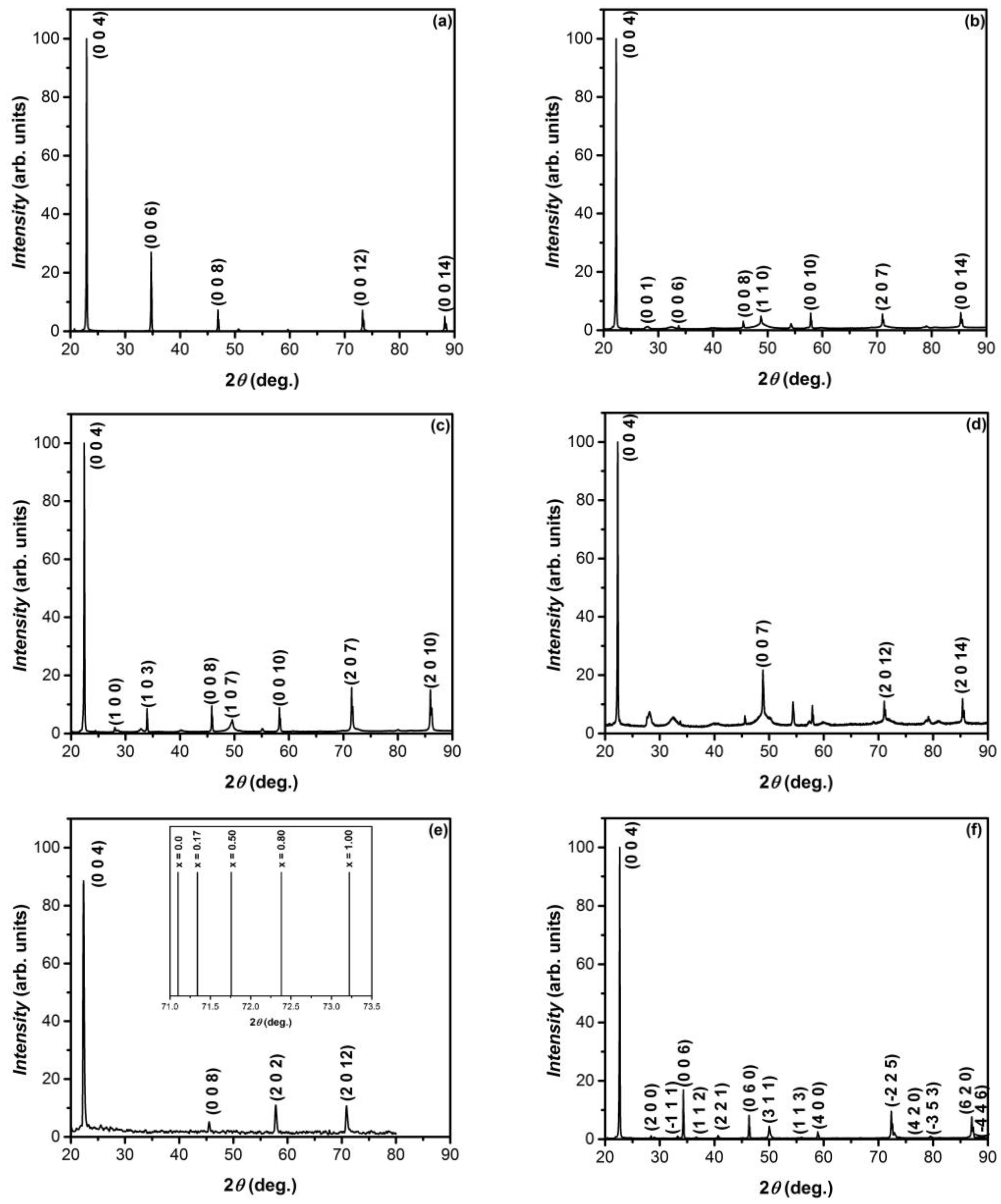
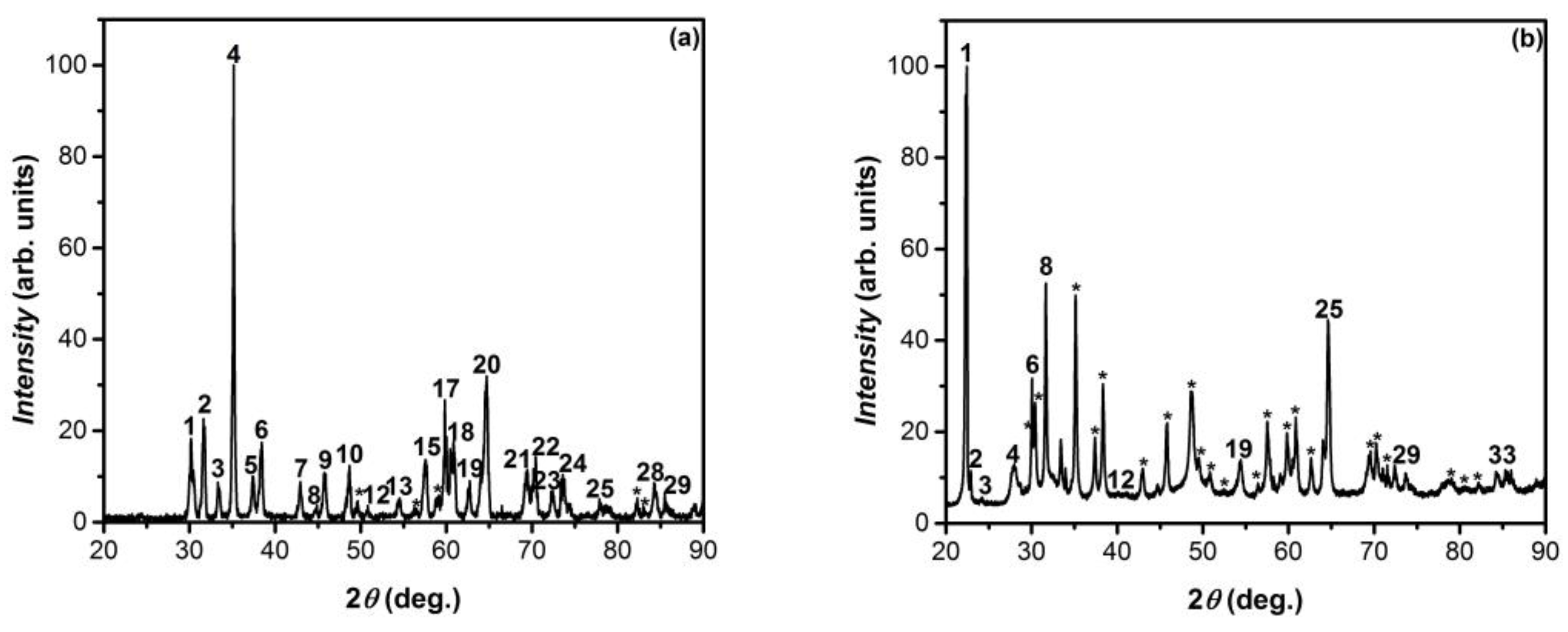
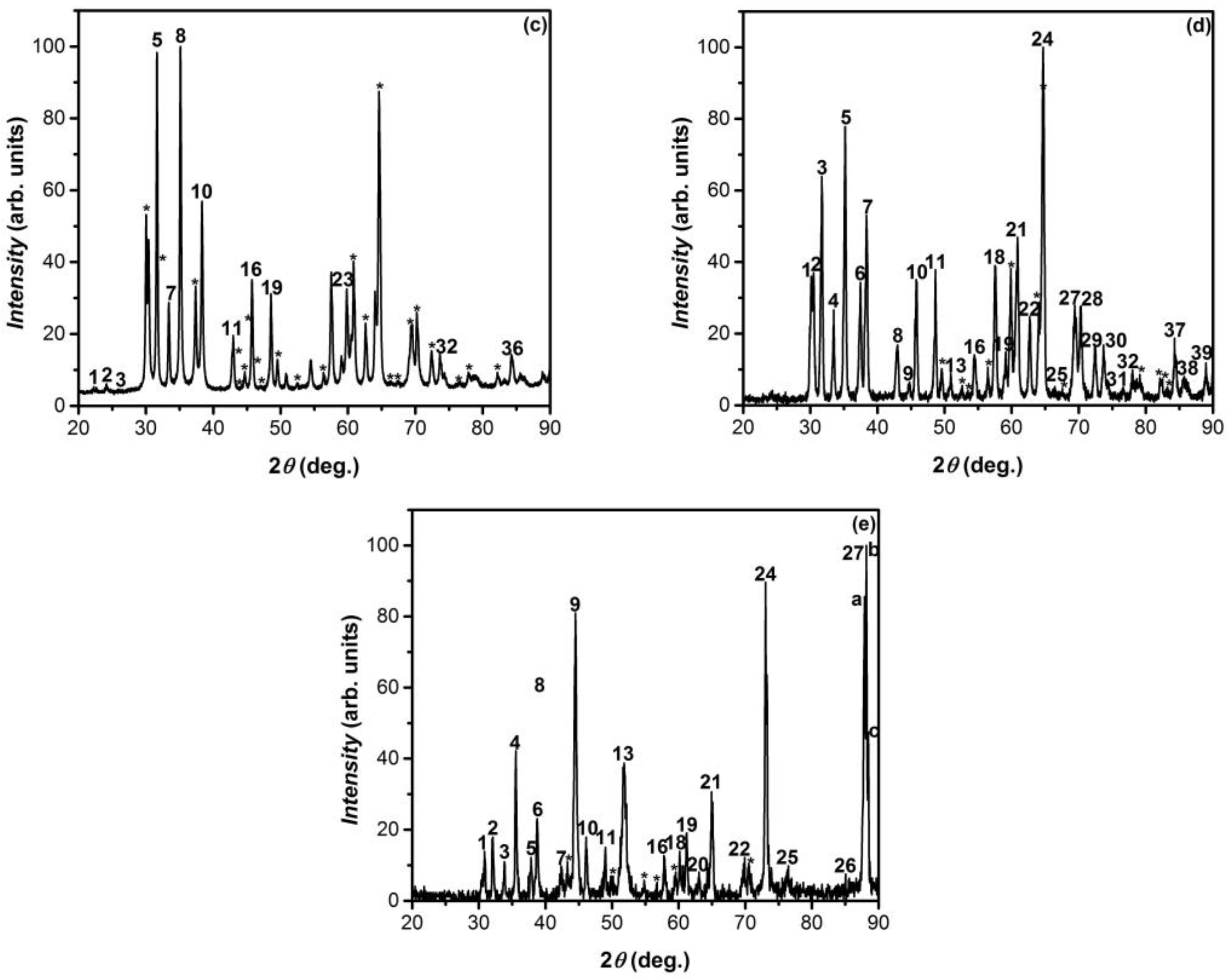
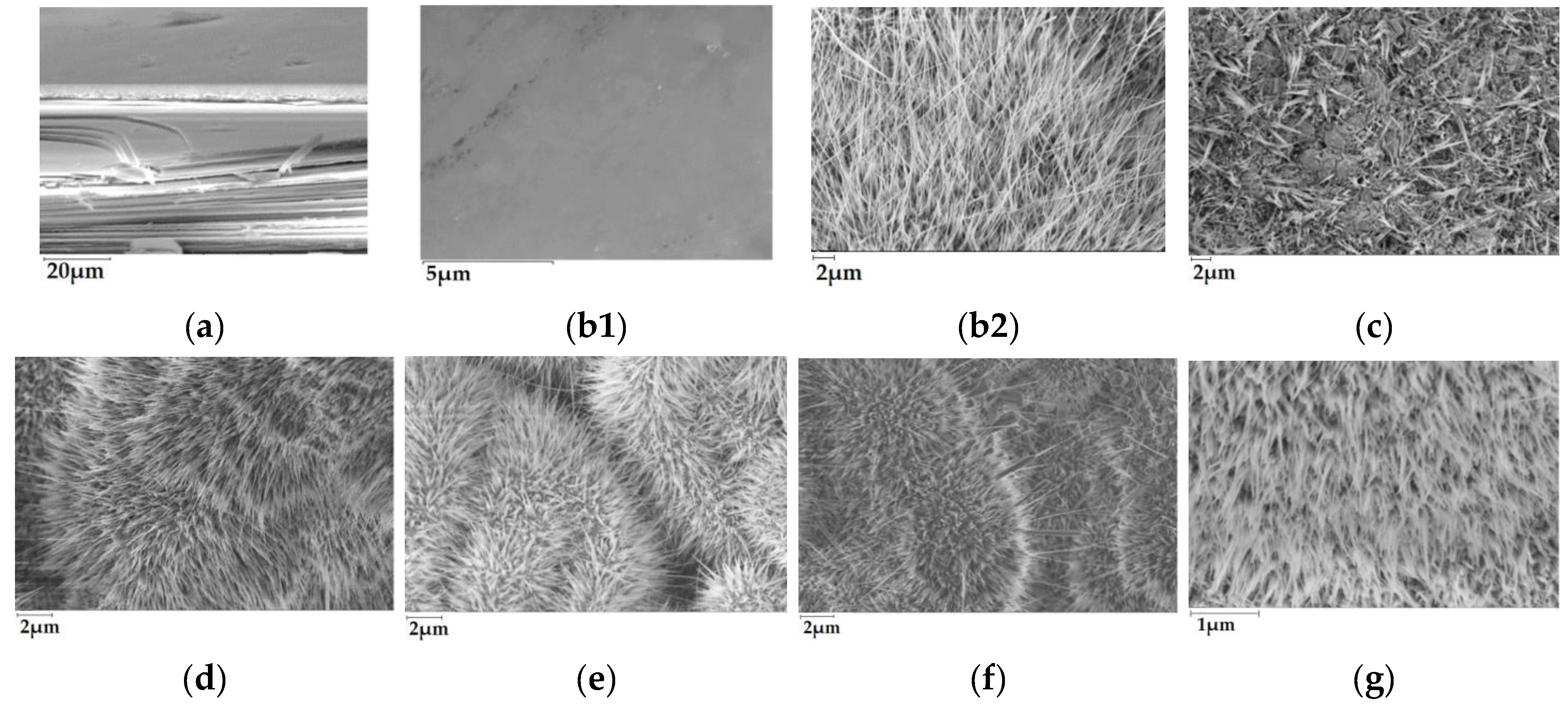


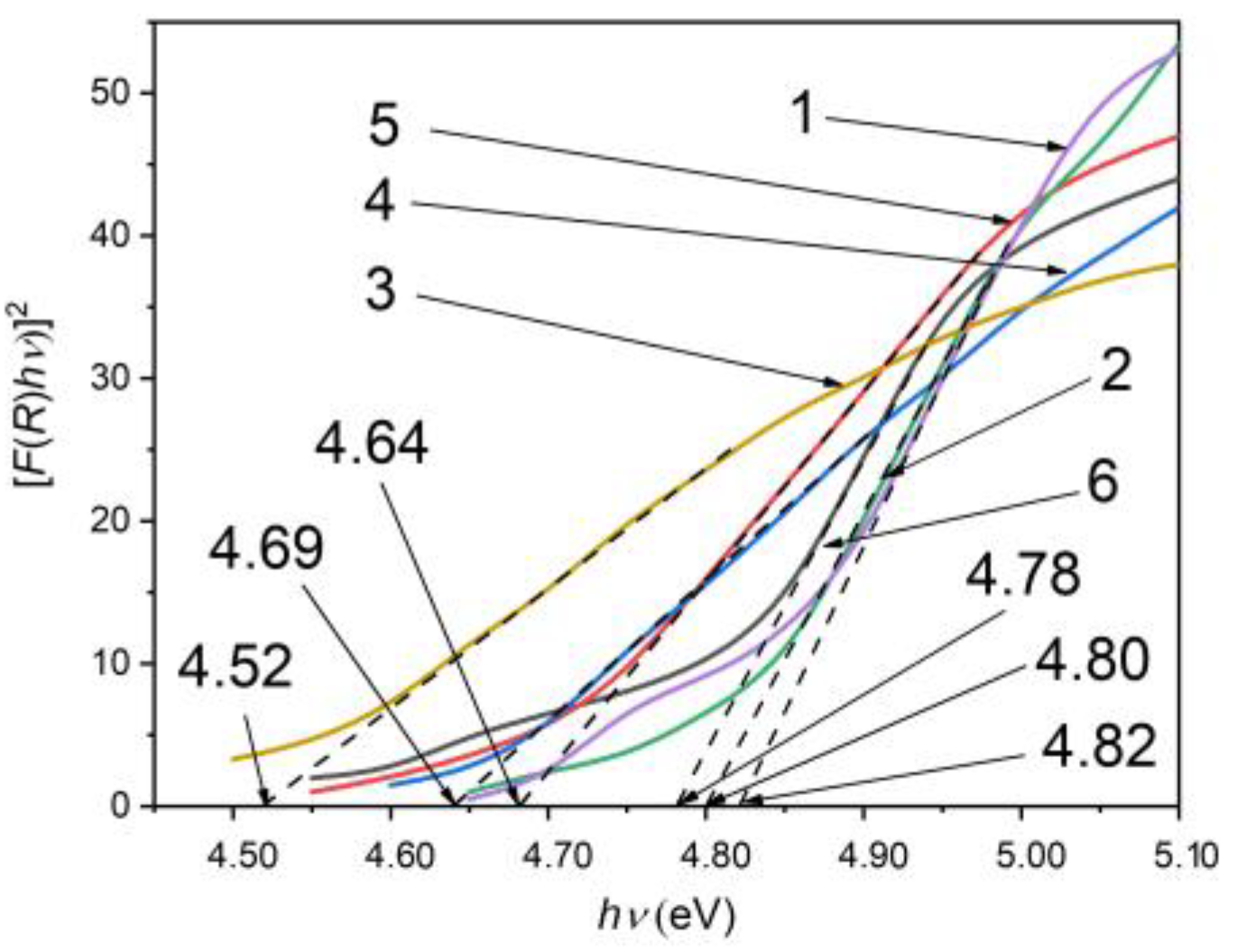

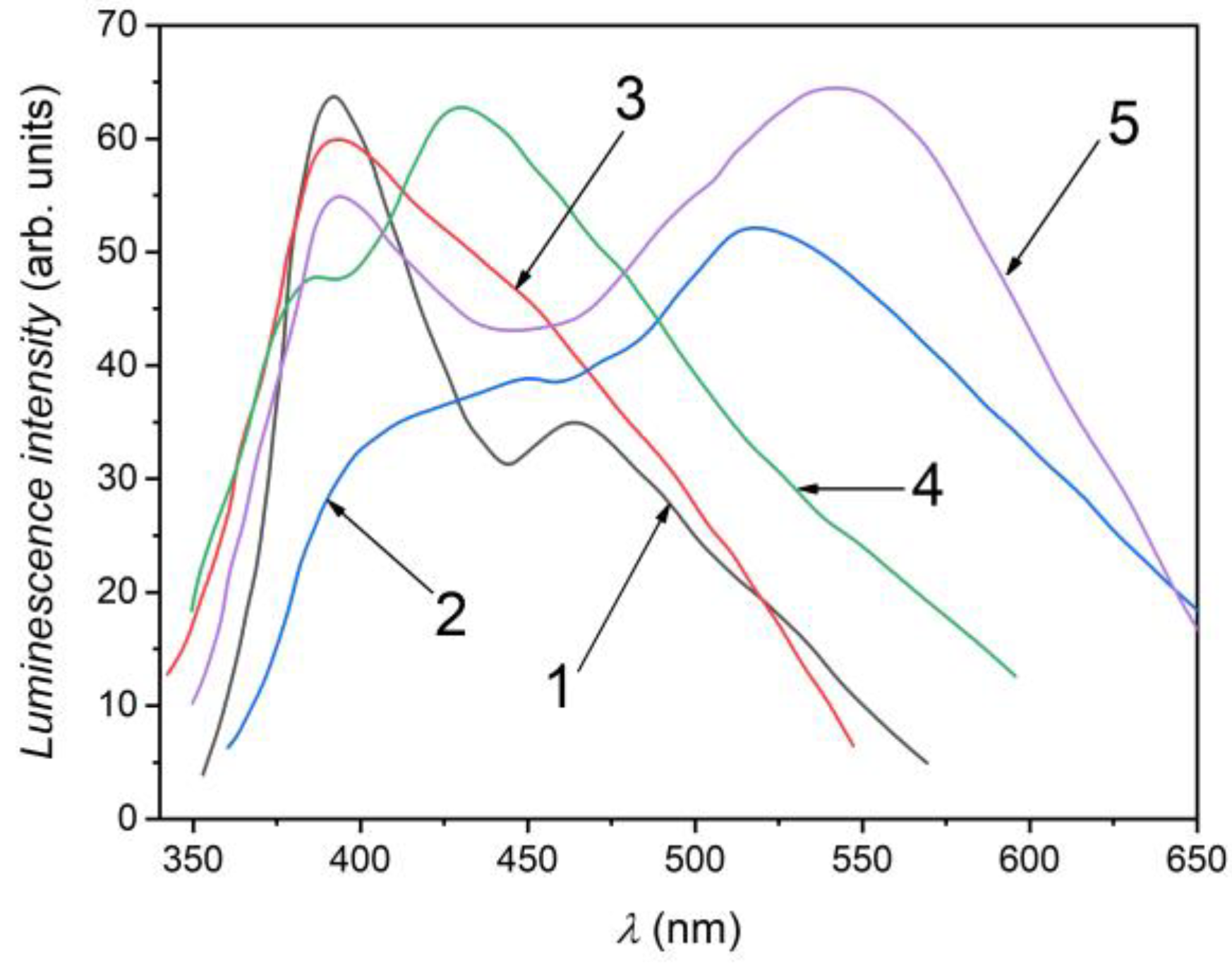
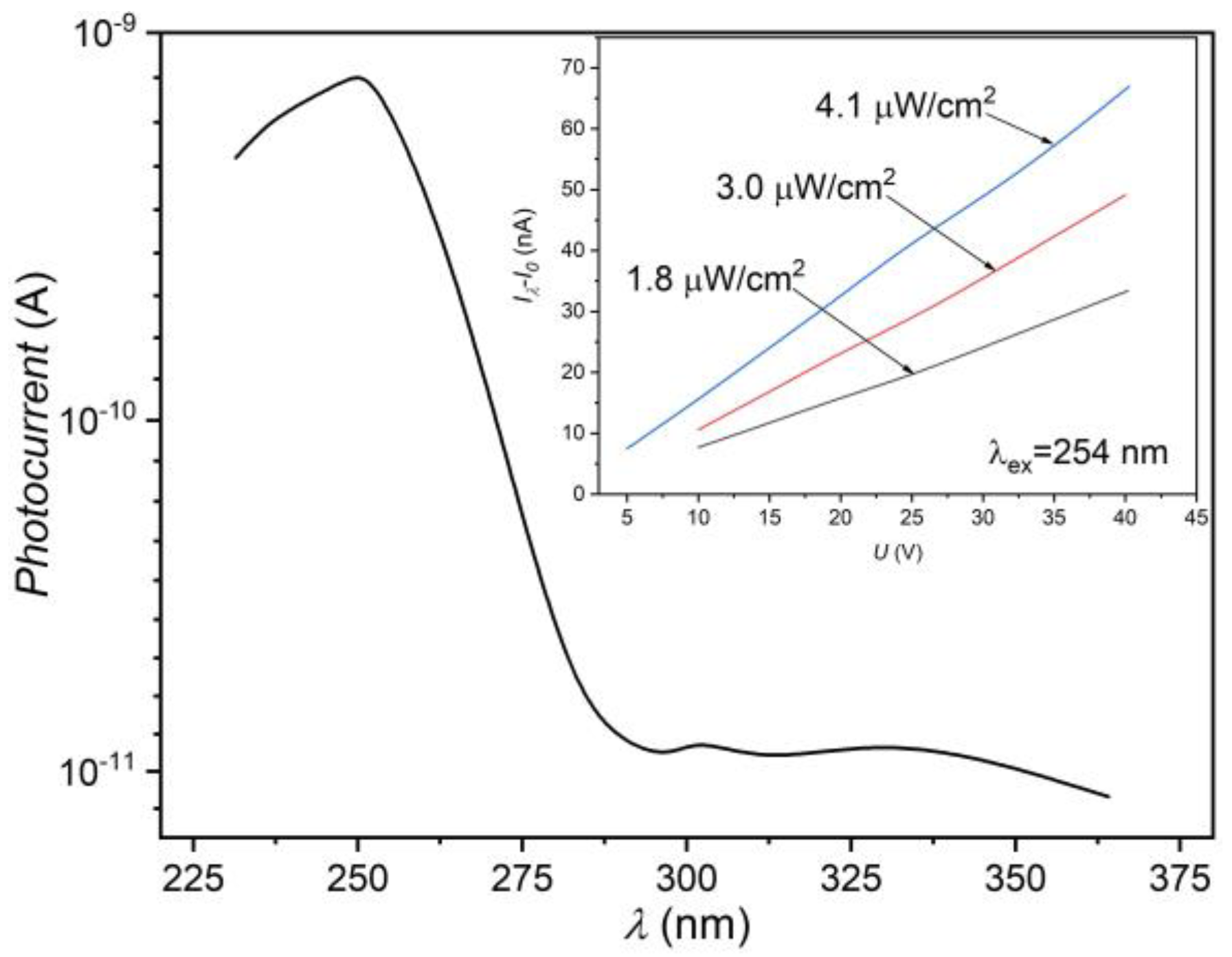
| Composition (x) of the Primary Compound GaSxSe1−x | Heat Treatment Temperature, °C | Heat Treatment Duration, h | Concentration, at. % | CGa/CO | |
|---|---|---|---|---|---|
| CO | CGa | ||||
| 1.00 | 850 | 6.0 | 59.33 | 40.67 | 2/2.92 |
| 1.00 | 900 | 0.5 | 56.08 | 43.92 | 2/2.60 |
| 0.80 | 900 | 6.0 | 60.78 | 39.22 | 2/3.10 |
| 0.50 | 900 | 6.0 | 61.01 | 38.99 | 2/3.13 |
| 0.17 | 900 | 6.0 | 53.15 | 46.85 | 2/2.30 |
| 0.05 | 900 | 6.0 | 57.40 | 42.60 | 2/2.70 |
| No | Sulfur Concentration x in GaSxSe1−x Solid Solution Substrate | ||||||||||||
|---|---|---|---|---|---|---|---|---|---|---|---|---|---|
| x = 0.0, t = 750 °C | x = 0.0, t = 900 °C | x = 0.17, t = 900 °C | x = 0.5, t = 900 °C | x = 0.8, t = 900 °C | x = 1.0, t = 900 °C | Symm. [5] | |||||||
| , cm−1 | Int., a.u. | , cm−1 | Int., a.u. | , cm−1 | Int., a.u. | , cm−1 | Int., a.u. | , cm−1 | Int., a.u. | , cm−1 | Int., a.u. | ||
| 1 | 73.0 | 10 | 120.0 | 15 | 114.0 | 22 | 117.0 | 20 | 115.0 | 31 | 114.0 | 22 | Bg |
| 2 | 86.0 | 78 | 158.0 | 42 | 146.0 | 31 | 145.0 | 36 | 145.0 | 28 | 144.0 | 31 | Bg |
| 3 | 113.5 | 95 | 179.0 | 67 | 173.0 | 40 | 172.0 | 179 | 174.0 | 42 | 171.0 | 40 | Ag |
| 4 | 147.0 | 15 | 207.0 | 227 | 201.0 | 100 | 119.0 | 860 | 199.0 | 85 | 199.0 | 100 | Ag |
| 5 | 186.5 | 93 | 328.0 | 43 | 322.0 | 33 | 321.0 | 44 | 324.0 | 27 | 323.0 | 33 | Ag |
| 6 | 231.6 | 63 | 355.0 | 89 | 349.0 | 49 | 284.0 | 375 | 348.0 | 52 | 348.0 | 49 | Ag |
| 7 | 290.0 | 23 | 422.0 | 85 | 416.0 | 50 | 414.0 | 428 | 417.0 | 58 | 415.0 | 50 | Ag |
| 8 | 357.0 | 100 | 484.0 | 42 | 478.0 | 35 | 476.0 | 72 | 478.0 | 36 | 475.0 | 35 | Ag |
| 9 | 384.6 | 19 | 636.0 | 41 | 630.0 | 36 | 629.0 | 347 | 628.0 | 30 | 633.0 | 36 | Ag |
| 10 | 662.0 | 79 | 656.0 | 47 | 655.0 | 347 | 657.0 | 48 | 655.0 | 47 | Ag | ||
| 11 | 773.0 | 109 | 767.0 | 58 | 762.0 | 467 | 765.0 | 56 | 765.0 | 58 | Ag | ||
Disclaimer/Publisher’s Note: The statements, opinions and data contained in all publications are solely those of the individual author(s) and contributor(s) and not of MDPI and/or the editor(s). MDPI and/or the editor(s) disclaim responsibility for any injury to people or property resulting from any ideas, methods, instructions or products referred to in the content. |
© 2023 by the authors. Licensee MDPI, Basel, Switzerland. This article is an open access article distributed under the terms and conditions of the Creative Commons Attribution (CC BY) license (https://creativecommons.org/licenses/by/4.0/).
Share and Cite
Sprincean, V.; Leontie, L.; Caraman, I.; Lupan, O.; Adeling, R.; Gurlui, S.; Carlescu, A.; Doroftei, C.; Caraman, M. Preparation, Chemical Composition, and Optical Properties of (β–Ga2O3 Composite Thin Films)/(GaSxSe1−x Lamellar Solid Solutions) Nanostructures. Nanomaterials 2023, 13, 2052. https://doi.org/10.3390/nano13142052
Sprincean V, Leontie L, Caraman I, Lupan O, Adeling R, Gurlui S, Carlescu A, Doroftei C, Caraman M. Preparation, Chemical Composition, and Optical Properties of (β–Ga2O3 Composite Thin Films)/(GaSxSe1−x Lamellar Solid Solutions) Nanostructures. Nanomaterials. 2023; 13(14):2052. https://doi.org/10.3390/nano13142052
Chicago/Turabian StyleSprincean, Veaceslav, Liviu Leontie, Iuliana Caraman, Oleg Lupan, Rainer Adeling, Silviu Gurlui, Aurelian Carlescu, Corneliu Doroftei, and Mihail Caraman. 2023. "Preparation, Chemical Composition, and Optical Properties of (β–Ga2O3 Composite Thin Films)/(GaSxSe1−x Lamellar Solid Solutions) Nanostructures" Nanomaterials 13, no. 14: 2052. https://doi.org/10.3390/nano13142052







